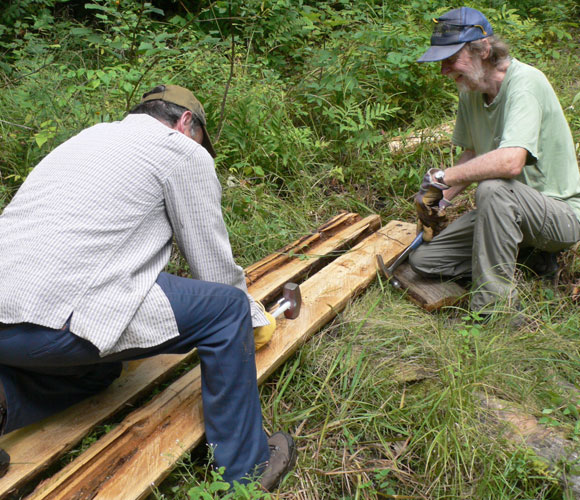
FARMINGTON – Commissioners approved a list of projects for financial support today, through a tax increment financing account maintained by the county for the Kibby Wind Project.
Commissioners accepted the suggestions of the TIF Application Review Team to fund eight projects in the Unorganized Territories and three scholarships for U.T. residents seeking employment training. The application review team, made up of U.T. residents, Alison Hagerstrom of the Greater Franklin Development Corporation and County Clerk Julie Magoon, recommended using $85,774 in funds captured by the Kibby Wind Project’s TIF to fund the applicants’ projects, which include rescue equipment, scenic byway upgrades and trail improvements.
Through the 2008 TIF agreement between the state, county and project developer TransCanada, 75 percent of tax revenues through the Kibby Wind Project were captured, with 60 percent of that amount returned to the company. The other 40 percent, or an estimated $4 million over a 20-year period, was taken by the county for the use of economic development in the unorganized territories. Commissioners approved the TIF plan because they were interested in seeing the benefits of the project go toward local projects, rather than be absorbed by the state.
In November 2011, the team responsible for making recommendations regarding the allocation of TIF funds held a workshop in Eustis. Organizations and individuals interested in using the funds for tourism, public safety or economic development projects in the U.T. attended the workshop and submitted letters of intent to the team. Hagerstrom said Tuesday that the team had reviewed and scored each project application separately, then collectively averaged the scores to determine each project’s worthiness.
This year, due to the number of applicants and sufficient funding, the team recommended fulfilling at least part of each request. In future years, Hagerstrom noted, the competition for the funds would likely increase as word about the system got out.
“It will be trickier next time,” Hagerstrom told commissioners, “because people will be even more energized.”
Commissioners agreed to fund all eight projects and three scholarships, using roughly $86,000 of $98,000 set aside for that purpose by the TIF. Organizations applying for funds include Franklin Search & Rescue, a wilderness rescue team who applied for $4,380 to purchase communications equipment, as well as three scenic byway improvement projects:
The Flagstaff Area Business Association applied for $25,000 for work on a scenic byway turnout in Wyman Township. Hagerstrom said the team recommended awarding $23,000 in funding, subtracting $2,000 in requests for planning money that the team felt could be folded into other planning work. Two other scenic byway projects, one in the Route 27 corridor and the other in Madrid, also were approved for funding. The Madrid project, which is being undertaken by Rangeley Lakes Heritage Trust, includes $20,000 to begin a multi-phase process of creating a turnout on Route 4 at the site of a former gas station alongside the river.
The four other projects were trail improvements; a total of $32,000 for the Fly Rod Crosby Trail, a snowmobile trail project near Bag Pond Mountain, a birding trail along Perham Stream and a multi-purpose trail in Redington. These projects, Hagerstrom and other team members said, either connected or extended existing trails to create larger networks.
Three U.T. residents also received a total of $6,000 to go toward employment training scholarships. In the future, commissioners discussed the viability of funding a separate scholarship account for the use of U.T. students. At minimum, team members asked commissioners to consider separating the project and scholarship submission time lines, as some would-be students were working under deadlines to secure funds for classes.
Commissioners asked questions about specific projects but generally commended the team for its work in allocating the funds for their intended purpose; economic development in the U.T. Team members, including Gary Perlson of Madrid, Bill Gilmore of Freeman Township and David Robie, who also lives in Madrid, but represents the Franklin County Chamber of Commerce, said they felt the process had been a positive one.
“Looking at this as a whole,” Perlson said, “this is an improvement for the entire county.”
The team intends to continue to keep tabs on all projects that received TIF funding, members added, to ensure the funds were used for their proper purposes. Invoices from contractors, environmental assessment companies and other involved businesses could also be used for that purpose.
Other team members include Richard Fotter of Wyman Township and Bob Carlton of Freeman Township.





This Great News! Franklin Search & Rescue (FSAR) is currently relying on a set of team ‘talk about’ UHF radios (like those used by families when skiing) for scene communication! This grant will allow us to purchase 6 VHF narrow band 16-channel portable radios so we can communicate with all participating agencies at the rescue scene which can include, fire departments, NorthStar ambulance, wardens and law enforcement and each other. We respond to 10-15 search and rescue calls each year all over the state of Maine.
FSAR is an all volunteer SAR group based in Kingfield. We meet on the 2nd Wednesday of the month at the Kingfield fire station at 6:30 p.m. All interested people are encouraged to come check us out.
Steve Mitman
Secretary, FSAR
I would like to echo Steve’s comment; great news! Over time these grants will make a big difference for small community groups focused on improving and enhancing economic prospects in the Unorganized Territories. They will also help us upgrade our emergency response capabilities as new trails are developed and more people use them.
Money awarded to the Fly Rod Crosby Trail will go toward providing local youth with meaningful summer jobs, contribute toward signage, maps, parking and all the other stuff that goes into trails that people don’t think about. If anyone would like to find out more about the project or get involved this summer, please visit . We are excited to receive this grant and look forward to getting back out on the trail this summer!
Ben Godsoe
High Peaks Alliance